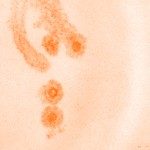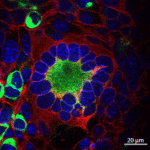Lien vers Pubmed [PMID] – 22046126
PLoS Pathog. 2011 Oct;7(10):e1002306
Human infection by simian foamy viruses (SFV) can be acquired by persons occupationally exposed to non-human primates (NHP) or in natural settings. This study aimed at getting better knowledge on SFV transmission dynamics, risk factors for such a zoonotic infection and, searching for intra-familial dissemination and the level of peripheral blood (pro)viral loads in infected individuals. We studied 1,321 people from the general adult population (mean age 49 yrs, 640 women and 681 men) and 198 individuals, mostly men, all of whom had encountered a NHP with a resulting bite or scratch. All of these, either Pygmies (436) or Bantus (1085) live in villages in South Cameroon. A specific SFV Western blot was used and two nested PCRs (polymerase, and LTR) were done on all the positive/borderline samples by serology. In the general population, 2/1,321 (0.2%) persons were found to be infected. In the second group, 37/198 (18.6%) persons were SFV positive. They were mostly infected by apes (37/39) FV (mainly gorilla). Infection by monkey FV was less frequent (2/39). The viral origin of the amplified sequences matched with the history reported by the hunters, most of which (83%) are aged 20 to 40 years and acquired the infection during the last twenty years. The (pro)viral load in 33 individuals infected by a gorilla FV was quite low (<1 to 145 copies per 10(5) cells) in the peripheral blood leucocytes. Of the 30 wives and 12 children from families of FV infected persons, only one woman was seropositive in WB without subsequent viral DNA amplification. We demonstrate a high level of recent transmission of SFVs to humans in natural settings specifically following severe gorilla bites during hunting activities. The virus was found to persist over several years, with low SFV loads in infected persons. Secondary transmission remains an open question.



